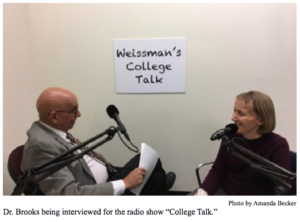Brooks studies how Asians have Been Viewed by Americans
 “I went to a high school in northern California, up in the foothills near where gold was discovered in a little town called Auburn, and one thing I remember is that we didn’t really have any kind of world history.” Those are the first memories of the historian Charlotte Brooks about her profession.
“I went to a high school in northern California, up in the foothills near where gold was discovered in a little town called Auburn, and one thing I remember is that we didn’t really have any kind of world history.” Those are the first memories of the historian Charlotte Brooks about her profession.
Further, when it comes to her area of specialization—the history of Asians in America—her beginnings are even more modest. “Growing up in the gold rush country, I saw the old Chinese immigrant markers on the land and on the buildings everywhere. I knew my town had been a big center of Japanese immigration. Japanese-Americans were moved in 1942, and most of them never returned because of racist agitation. But nobody talked about it. When I went to college, I tried to take courses to remedy what I felt was my awful lack of knowledge about anything besides U.S. history, and I really got hooked on China.”
A native of Huntington Beach, California, Brooks went on to obtain a bachelor’s degree from Yale and a master’s and a doctorate in history from Northwestern University in Illinois. Today she is a professor in the Department of History at the Weissman School of Arts and Sciences at Baruch College.
Although Chinese-Americans are a sizable part of the immigrant population of the U.S., it took a long time for them to be accepted in this country. “Chinese Americans have been in the United States since the 1850s, but they weren’t allowed to become citizens until 1943 if they immigrated here. If you were born on American soil, you are a citizen, but what that meant was that this community took a very long time to create a sizable second generation,” says Brooks.
At the same time that Japanese American were being interned in concentration camps in this country, Chinese-Americans started to be accepted. “After World War II, a lot of people were able to bring especially their wives and fiancés. You had these family communities for the first time, and other Americans saw them as almost surrogates for China, but what China meant in the late ‘40s, 50s, and ‘60s was this international competition between the People’s Republic of China, with which the United States had no relationship, and the Republic of China on Taiwan, which was America’s China, supposedly the ‘good China.’”
Interestingly enough, Brooks went on to write a book about two political personalities that could not be more different from each other: Mao Zedong and the most rabid anticommunist in American politics, Senator Joseph McCarthy. “I picked those two people as the extremes that really bound Chinese-American politics and limited them. The argument of the book was that in fact, like any other community in America, very few people were on the far right or far left; most people fell in the middle. Most people in these communities were actually moderates or liberals, but the loudest voices were on the right because they were the anticommunist voices. So that’s what the book is about, looking at the politics of these people,” she explains.
Brooks inevitably looks at the issue of racism and the stereotyping of Asian-Americans. “Very famously Time and Life magazines printed these really racist, horrible caricatures of Chinese and Japanese faces and said, ‘How to tell your friends from the Japs.’ That was one of the arguments for the repeal of the Chinese Exclusion Act in 1943. It happened during wartime as a gesture to America’s ally. The message was used by the Japanese during WWII to suggest that ‘America’s your ally, but they don’t want you immigrating.’ A lot of the speeches against repeal mentioned the Japanese, mentioned the so called ‘yellow peril,’ ‘Asian menace,’ or at the time, ‘oriental menace.’ The feelings and politics against them were deeply intertwined.”
Despite all these barriers, Chinese-Americans have had an impact in American politics. “Chinese-Americans were instrumental in the rise of progressive politics in the San Francisco Bay Area. But when you think about the number of Chinese-Americans who have served in Congress from New York, it’s one person. She was elected a few years ago. I don’t really know if there’s currently a Chinese-American serving in the state legislature; only two, I think, of 51 council members have Chinese ancestry, but the Chinese population of the city is 12 percent, and that’s extraordinary compared to the West Coast, an absolutely extraordinary difference.”
One of the movies that have influenced American understanding of the history of China is 55 Days at Peking. “I still show clips to my Asian-American history class to help them understand stereotypes. The way that it’s based on the Boxer Uprising, this anti-foreign uprising in 1900, but it’s so obviously about the way that the United States is viewing China in the 1950s,” she explains.
She explains that there was a lot of resentment of these portrayals in films and in cartoons and other media, and that the issue grew in importance with the generation that grew up after World War II and came of age in the 1960s. “They were influenced by the civil rights movement and what was called the Asian-American movement. They really—and I think rightly so—began to focus not just on bread and butter issues but also on issues that are a little bit more ephemeral, cultural issues that really make an imprint on people’s minds about how they treat others.”
PDF Version:
Brooks studies how Asians have been viewed by Americans